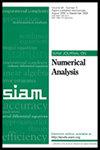相场晶体型模型中三种有效类龙格-库塔方法原始能量定律的统一框架
IF 2.9
2区 数学
Q1 MATHEMATICS, APPLIED
引用次数: 0
摘要
SIAM数值分析杂志,第63卷,第4期,1808-1832页,2025年8月。摘要。建立相场方程龙格-库塔方法的原始能量耗散规律的主要理论障碍是在不假设非线性体整体Lipschitz连续性的情况下验证阶段解的最大范数有界性。针对Swift-Hohenberg和相场晶体模型,我们提出了三种有效的龙格-库塔方法的能量稳定性的统一理论框架,包括加性隐式-显式龙格-库塔方法、显式指数龙格-库塔方法和校正积分因子龙格-库塔方法。通过标准的离散能量论证,证明了当相关的微分矩阵为正定时,三类龙格-库塔方法保持原有的能量耗散规律。我们的主要工具包括微分形式与相关的微分矩阵,离散正交卷积核,以及数学归纳法原理。通过计算相关微分矩阵的最小特征值下界,对文献中已有的许多龙格-库塔方法进行了重新审视。我们的理论方法为研究耗散半线性抛物问题的龙格-库塔方法的内部非线性稳定性开辟了一条新的途径。本文章由计算机程序翻译,如有差异,请以英文原文为准。
A Unified Framework on the Original Energy Laws of Three Effective Classes of Runge–Kutta Methods for Phase Field Crystal Type Models
SIAM Journal on Numerical Analysis, Volume 63, Issue 4, Page 1808-1832, August 2025.
Abstract. The main theoretical obstacle to establishing the original energy dissipation laws of Runge–Kutta methods for phase field equations is verifying the maximum norm boundedness of the stage solutions without assuming global Lipschitz continuity of the nonlinear bulk. We present a unified theoretical framework for the energy stability of three effective classes of Runge–Kutta methods, including the additive implicit-explicit Runge–Kutta, explicit exponential Runge–Kutta, and corrected integrating factor Runge–Kutta methods, for the Swift–Hohenberg and phase field crystal models. By the standard discrete energy argument, it is proven that the three classes of Runge–Kutta methods preserve the original energy dissipation law if the associated differentiation matrices are positive definite. Our main tools include the differential form with the associated differentiation matrix, the discrete orthogonal convolution kernel, and the principle of mathematical induction. Many existing Runge–Kutta methods in the literature are revisited by evaluating the lower bound on the minimum eigenvalues of the associated differentiation matrices. Our theoretical approach paves a new way toward the internal nonlinear stability of Runge–Kutta methods for dissipative semilinear parabolic problems.
Abstract. The main theoretical obstacle to establishing the original energy dissipation laws of Runge–Kutta methods for phase field equations is verifying the maximum norm boundedness of the stage solutions without assuming global Lipschitz continuity of the nonlinear bulk. We present a unified theoretical framework for the energy stability of three effective classes of Runge–Kutta methods, including the additive implicit-explicit Runge–Kutta, explicit exponential Runge–Kutta, and corrected integrating factor Runge–Kutta methods, for the Swift–Hohenberg and phase field crystal models. By the standard discrete energy argument, it is proven that the three classes of Runge–Kutta methods preserve the original energy dissipation law if the associated differentiation matrices are positive definite. Our main tools include the differential form with the associated differentiation matrix, the discrete orthogonal convolution kernel, and the principle of mathematical induction. Many existing Runge–Kutta methods in the literature are revisited by evaluating the lower bound on the minimum eigenvalues of the associated differentiation matrices. Our theoretical approach paves a new way toward the internal nonlinear stability of Runge–Kutta methods for dissipative semilinear parabolic problems.
求助全文
通过发布文献求助,成功后即可免费获取论文全文。
去求助
来源期刊
CiteScore
4.80
自引率
6.90%
发文量
110
审稿时长
4-8 weeks
期刊介绍:
SIAM Journal on Numerical Analysis (SINUM) contains research articles on the development and analysis of numerical methods. Topics include the rigorous study of convergence of algorithms, their accuracy, their stability, and their computational complexity. Also included are results in mathematical analysis that contribute to algorithm analysis, and computational results that demonstrate algorithm behavior and applicability.

 求助内容:
求助内容: 应助结果提醒方式:
应助结果提醒方式:


